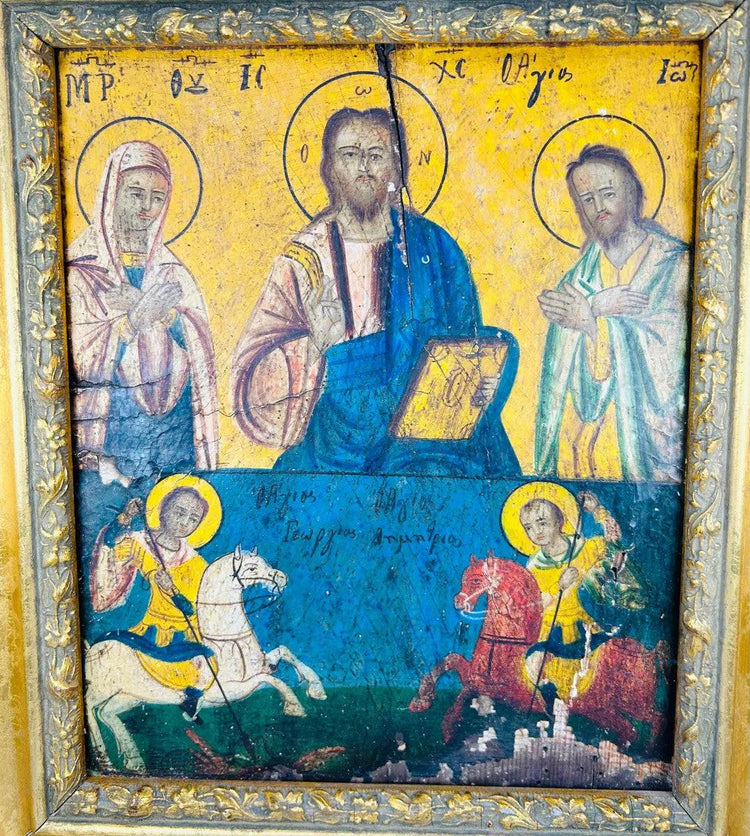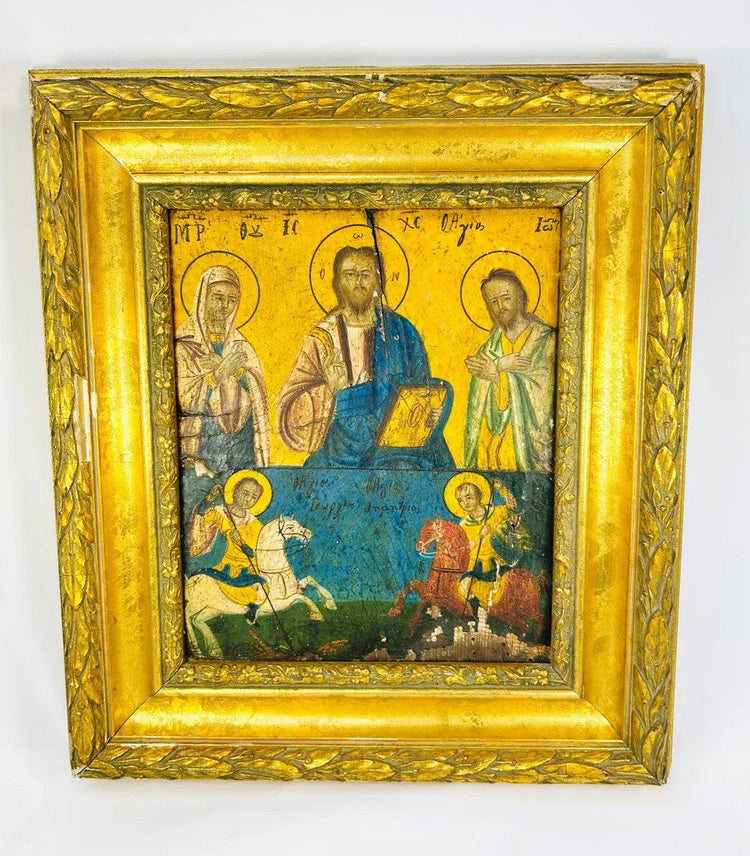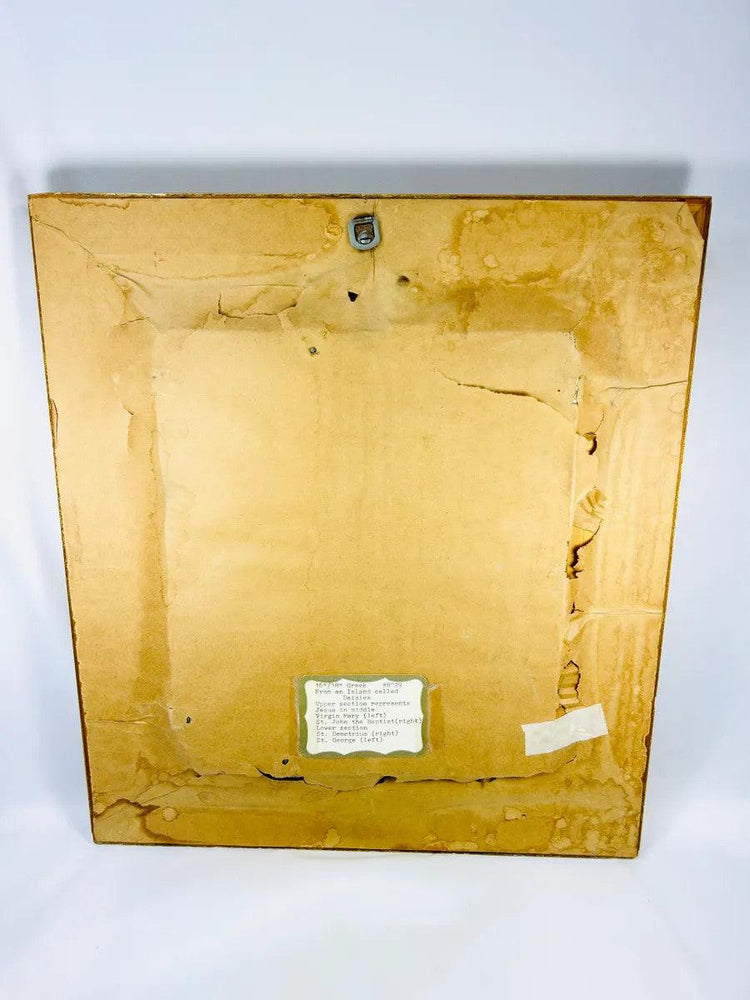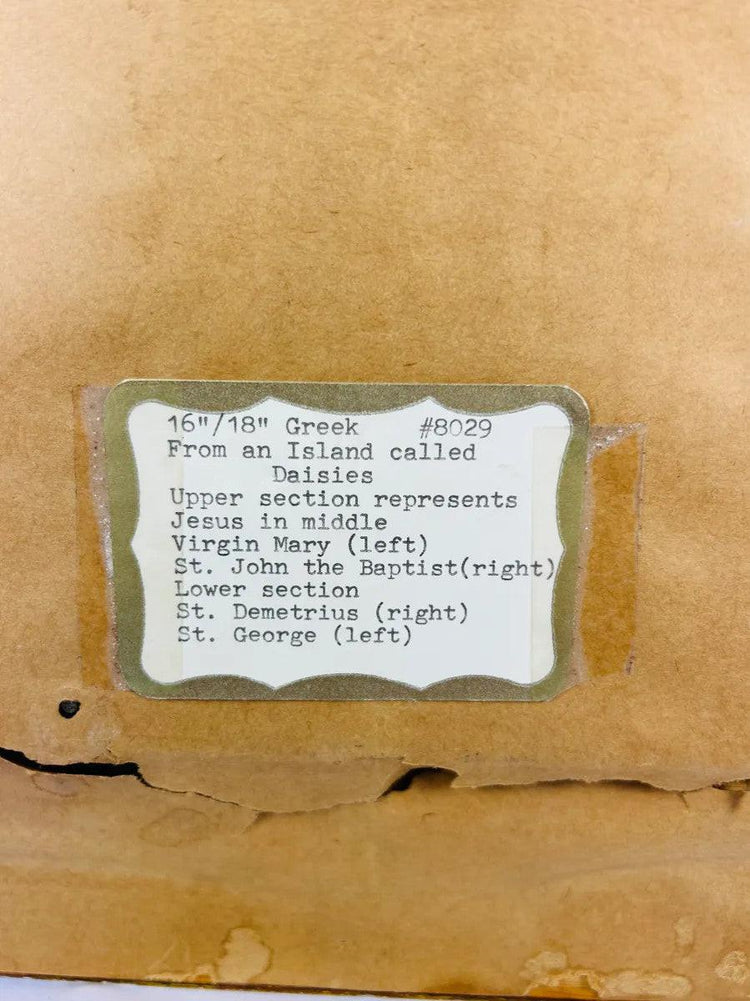Hand-Painted Greek Orthodox Icon on Wood | Christ Pantocrator with Saints | 16th–18th Century
Description
More
Less
Historical Context & Origin
Region: Greece or Eastern Europe (Greek Orthodox Tradition)
Material: Hand-painted tempera and gilt on wood panel
Period: 16th–18th Century
Description
This exceptional hand-painted Greek Orthodox icon depicts Christ Pantocrator surrounded by attendant saints, a revered composition symbolizing divine authority and mercy. Created between the 16th and 18th centuries, the icon exemplifies the sacred artistry of Byzantine and post-Byzantine devotional painting—meticulously rendered in tempera pigments and gold on a wooden panel.
The figure of Christ is portrayed with the Gospel Book in His left hand and the right hand raised in benediction, framed by a radiant halo and inscribed cross. The surrounding saints, rendered with expressive faces and intricate robes, reflect the mastery and spiritual depth of Orthodox iconography. Subtle craquelure and oxidation of the gilding enhance its authenticity and devotional character.
Features
- Rare hand-painted Greek Orthodox icon of Christ Pantocrator with Saints
- Executed in egg tempera and gold leaf on wood panel
- Vivid coloration and traditional Byzantine composition
- Original gilt background with fine craquelure and age patina
- Displays exceptional preservation and spiritual depth
Cultural Significance
In Orthodox Christianity, icons serve not merely as images but as sacred windows to the divine—objects of veneration through which the faithful commune with the spiritual world. The Christ Pantocrator type, meaning “Ruler of All,” is one of the most venerated subjects in Christian art, representing both judgment and compassion. This icon reflects the enduring continuity of Byzantine aesthetics and spiritual devotion through centuries of religious tradition.
Condition
Excellent preservation for its age, with age-related wear and surface patina consistent with centuries of devotional use. Minor flaking and gilding oxidation present, enhancing its authenticity. Structurally stable and professionally conserved for display.
Dimensions (approximate)
Height: 15 in (38 cm)
Width: 12 in (30.5 cm)
Age
16th–18th Century
Learn More
Discover More About Christ Pantocrator: Pantocrator: The Most Important Icon
See Another Greek Orthodox Icon on Wood From The British Museum: Icon with the Triumph of Orthodoxy
Description
Historical Context & Origin
Region: Greece or Eastern Europe (Greek Orthodox Tradition)
Material: Hand-painted tempera and gilt on wood panel
Period: 16th–18th Century
Description
This exceptional hand-painted Greek Orthodox icon depicts Christ Pantocrator surrounded by attendant saints, a revered composition symbolizing divine authority and mercy. Created between the 16th and 18th centuries, the icon exemplifies the sacred artistry of Byzantine and post-Byzantine devotional painting—meticulously rendered in tempera pigments and gold on a wooden panel.
The figure of Christ is portrayed with the Gospel Book in His left hand and the right hand raised in benediction, framed by a radiant halo and inscribed cross. The surrounding saints, rendered with expressive faces and intricate robes, reflect the mastery and spiritual depth of Orthodox iconography. Subtle craquelure and oxidation of the gilding enhance its authenticity and devotional character.
Features
- Rare hand-painted Greek Orthodox icon of Christ Pantocrator with Saints
- Executed in egg tempera and gold leaf on wood panel
- Vivid coloration and traditional Byzantine composition
- Original gilt background with fine craquelure and age patina
- Displays exceptional preservation and spiritual depth
Cultural Significance
In Orthodox Christianity, icons serve not merely as images but as sacred windows to the divine—objects of veneration through which the faithful commune with the spiritual world. The Christ Pantocrator type, meaning “Ruler of All,” is one of the most venerated subjects in Christian art, representing both judgment and compassion. This icon reflects the enduring continuity of Byzantine aesthetics and spiritual devotion through centuries of religious tradition.
Condition
Excellent preservation for its age, with age-related wear and surface patina consistent with centuries of devotional use. Minor flaking and gilding oxidation present, enhancing its authenticity. Structurally stable and professionally conserved for display.
Dimensions (approximate)
Height: 15 in (38 cm)
Width: 12 in (30.5 cm)
Age
16th–18th Century
Learn More
Discover More About Christ Pantocrator: Pantocrator: The Most Important Icon
See Another Greek Orthodox Icon on Wood From The British Museum: Icon with the Triumph of Orthodoxy
You May Also Like



















